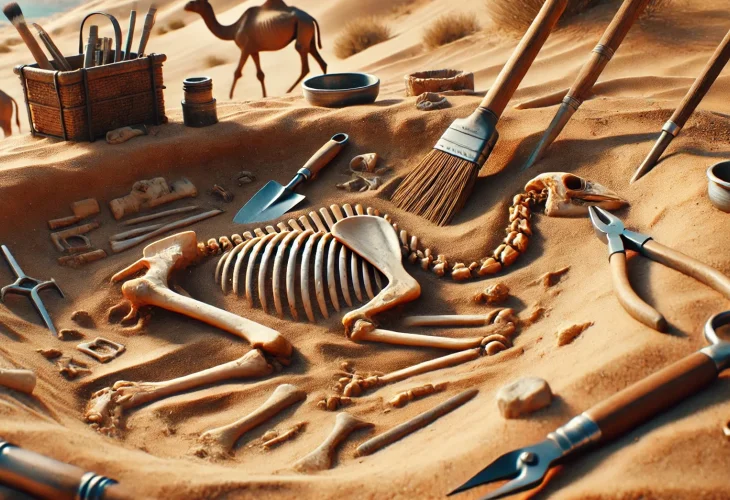Did They Miss the Camels? Unpacking a Fascinating Archaeological Mystery
Why are there no camel remains found in ancient sites, despite their usefulness in crossing deserts? This puzzle challenges our understanding of biblical history.

William Foxwell Albright was a renowned American archaeologist of the twentieth century, if not the most famous of them all. He was among the first to systematically excavate many biblical sites in Israel and authored numerous books and studies.
Albright was a man of faith, and most of his research supported Jewish tradition as described in the Torah and the Prophets. From 1922, he managed the American School of Oriental Research in Jerusalem. The following year, he discovered a new and unknown site near Jerusalem. From then on, he led numerous excavations and studies until his death in 1971.
Following each excavation, he published reports and articles showing how the archaeological reality supported the descriptions in the Bible. In cases where he faced difficulties, he sought ways to resolve them. However, exceptionally, after conducting extensive excavations in the Negev, he was greatly disappointed not to find any camel remains from the Bronze Age, the era of the Patriarchs. Albright wondered, since camels are indispensable for desert travel and deserts abound in the region, how could there be no camel remains? He reviewed dozens of excavations and hadn't found a single camel trace. Albright concluded that camels hadn't been domesticated during the time of the Patriarchs. Though useful, camels in their wild state were unusable.
What about the biblical story of Eliezer, Abraham's servant, and the camels? Despite Albright's faith, he suggested—albeit reluctantly—that this might have been a later addition to the Torah (heaven forbid).
This event is significant, especially because it involves a man of faith. It's a known principle that "absence of evidence is not evidence of absence." For those who rely solely on physical data, this approach is understandable. But for someone who believes in the sanctity of the Torah, having seen countless times how findings support it, would they really doubt its completeness just because of "absence of evidence"? As Jews of faith, even as we delve into research, it's only to enhance our knowledge. If findings don't support the Torah, we trust the text over what we haven't seen.
A little patience would have shown Albright that archaeological research is always quite incomplete. In fact, during Albright's time, camel findings started to appear. Albright himself mentions a 17th-century BCE text mentioning a camel as a domesticated animal needing feeding. Although this text is not from the land of Israel, it's clear that if camels were domesticated, a wealthy man like Abraham, who traveled from distant and wealthy lands, could have brought them along. This also explains the absence of remains, as camels might only have been accessible to the wealthy. The locals might not have known how to handle camels due to their size and lacked means to raise them. Naturally, with only a few camels existing four thousand years ago, their remains would be scarce.
During Albright's lifetime, Rabbi Schneur Zalman Lehman published a wealth of findings proving that camels were domesticated in the Patriarchs' days. In Mount Tawuq, 150 km east of Aqaba, 100 camels were carved into rock, dating back to the Mesolithic period. Shattered camel bones from the Neolithic period were found in Sha'ar HaGolan. At Tel Halaf, Oppenheim discovered a mural of a camel rider dating to 3000 BCE. "In Khablis," an Egyptian depiction of a camel, dates to the early second millennium. At Tel Far'ah, near Shechem, a camel jawbone from the Middle Bronze Age was found in a tomb. In Telloha, a camel was found. A Mitanni seal features a camel and rider, dated to the 14th-16th centuries BCE. In Helwan, Egypt, camel bones dated to 3200 BCE were found in 1947. A camel hair rope from the third or fourth millennium BCE was found in Stnata, also in Egypt, with many similar finds.
Albright was too set in his views to retract, but the next generation of researchers realized there was no real proof of camel absence. Meanwhile, camel traces were found in Israel itself, in the Chalcolithic site of Nahal Saqqarim in the Negev, the region of Abraham's wanderings.
Modern researchers summarize the findings: domestic Bactrian camel bones were discovered in eastern Turkistan, predated to the Chalcolithic period by Bodenheimer. Recently, Pri and Bodenheimer collected information proving domesticated camels existed in ancient Egypt, albeit infrequently, thus there's no need for alternative explanations for the biblical camel stories.
Finds collected by Pri include: a third-millennium camel hair rope, older artifacts, and pre-dynastic items. Among the finds, a 22nd-24th century BCE camel engraving found in Sona, a 14th-15th century BCE camel skull, and 13th-15th century BCE camel figurines. In Israel, a camel-shaped jug from the early second millennium was discovered.
"The prehistoric engravings on Kalwah rocks depict clear images of camels and cattle, and while there is no definitive proof, it seems these animals were already domesticated... Camel remains and images were known in ancient times in Egypt and Babylon. Although these findings are rare, they are consistent and uninterrupted... The scarcity of ancient camel depictions might be due to some religious taboo, or because the camel symbolizes the Bedouin, a long-time adversary of agricultural settlements."
So, we've learned an important lesson in faith, beneficial for us all. Even if a question seems big and unanswered, let's have a bit of humility, and sometimes patience. Research advances, and what seems today like a huge problem, might appear insignificant to future generations.

